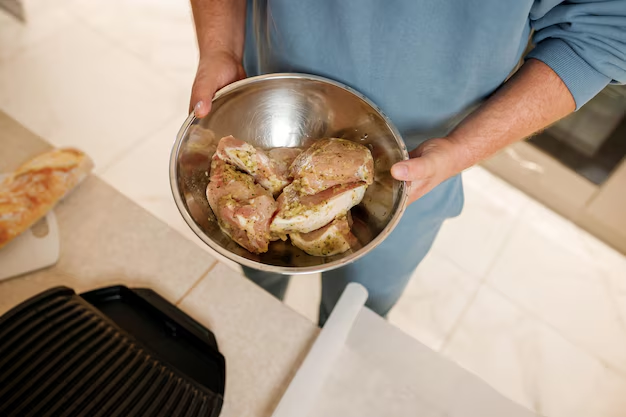Is It Safe to Put Hot Chicken in the Refrigerator?
Imagine you've just prepared a delicious chicken dinner. As you finish your meal, you may wonder if it's safe to place the leftover hot chicken directly into the refrigerator. Is this a culinary crime, or simply good practice for maintaining food safety? Let's explore this nuanced topic in detail.
Understanding Food Safety Basics
Food safety is a crucial part of food preparation and storage, ensuring that what we consume is nutritious and free from bacteria that can cause illness. One common question is whether it's safe to store hot food, like chicken, directly in the refrigerator. Before delving into this specific question, it's helpful to understand some food safety principles.
The Temperature Danger Zone
One key concept is the temperature danger zone, which ranges between 40°F and 140°F (4°C to 60°C). Within this range, bacteria can multiply rapidly, potentially reaching levels that can cause foodborne illnesses.
Avoiding Bacterial Growth
To minimize bacterial growth, it's essential to either keep foods below 40°F or above 140°F. Thus, when cooling hot food, the goal is to pass through the danger zone (70°F - 140°F) as quickly as possible.
Can You Refrigerate Hot Chicken?
The simple answer is yes, you can place hot chicken in the refrigerator, but there are a few considerations to ensure it’s done safely.
Factors to Consider
Container Size and Shape: Large, deep containers can slow cooling because the interior stays warm longer. Opt for shallow, wide containers to help the food cool quickly.
Portion Size: Smaller portions cool faster. Divide large quantities of chicken into smaller portions to facilitate quick chilling.
Position in Refrigerator: Placing hot chicken in specific areas of your refrigerator may influence the cooling rate. Ideally, ensure there's enough space around the container for air circulation, helping with rapid cooling.
Common Concerns and Myths
There are several common misconceptions about refrigerating hot chicken that need further exploration.
Myth 1: Hot Food Damages the Refrigerator
A concern for many is that placing hot chicken directly in the fridge will overwork or damage the appliance. While it’s true that hot foods can cause the refrigerator to work harder temporarily, modern refrigerators are typically designed to handle this situation efficiently.
Myth 2: Hot Chicken Will Spoil Faster
Some people believe hot food spoils faster in the refrigerator. In reality, as long as food is stored correctly, refrigerating hot foods helps prevent spoilage by quickly reducing the temperature and slowing bacterial growth.
Practical Tips for Refrigerating Hot Chicken 🥡
Time Management: Aim to refrigerate leftover chicken within two hours of cooking. The less time it spends in the danger zone, the safer it will be.
Use Appropriate Containers: Employ shallow containers to ensure a quicker drop in temperature.
Position for Airflow: Place food towards the back or near the sides where air circulates better but avoid overcrowding the space.
Monitoring Temperature: Utilize a kitchen thermometer to ensure your refrigerator stays below 40°F and check the internal temperature of leftovers regularly.
Related Food Safety Practices
Once you've safely stored your hot chicken in the refrigerator, it's essential to remember other aspects of safe food handling and storage.
Reheating Leftovers
When you're ready to enjoy those leftovers, reheating to an internal temperature of 165°F (74°C) is vital to kill any bacteria that may have developed.
Shelf Life of Refrigerated Chicken
Typically, refrigerated cooked chicken is safe to eat within three to four days. Always double-check for any changes in color, odor, or texture that might indicate spoilage.
Benefits of Proper Food Storage
Foodborne Illness Prevention: By minimizing time in the danger zone, proper storage drastically reduces the risk of foodborne diseases.
Preserving Quality: Correct storage practices help maintain food quality, flavor, and nutrition.
Reducing Waste: Efficient use of leftovers not only saves money but also conserves resources and reduces waste.
Quick Tips Summary 📝
- 🚦Maintain awareness of the temperature danger zone (40°F - 140°F).
- 🍲 Use shallow containers for faster cooling.
- ⏰ Refrigerate within two hours of cooking.
- ♻️ Transfer into appropriately-sized portions.
- 🔥 Reheat leftovers to at least 165°F.
By following these practices, you can enjoy your meals safely and reduce potential health risks.
Final Thoughts
Ultimately, refrigerating hot chicken isn't a question of whether it will harm the appliance, but rather how effectively you can navigate the food safety considerations involved. By understanding the basics of temperature control and safe food handling, you ensure both the longevity and safety of your meals, leading to healthier and more cost-effective food management at home.
Incorporating these guidelines into your daily routine can make a considerable difference in food safety, empowering you to enjoy your meals with the confidence that you're protecting yourself and your family from potential hazards.
